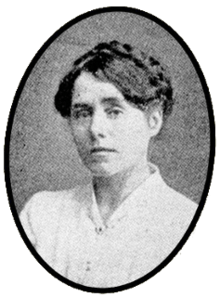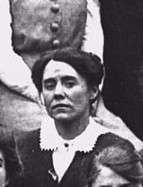Julia Grenan
Julia Grenan (Sighle, Sheila, 1884 – 6 January 1972) was an Irish nationalist, republican, suffragette and socialist and member of Cumann na mBan, best known for being one of the three last women to leave the Headquarters during the Easter Rising of 1916.
Julia Grenan | |
|---|---|
 | |
| Born | Julia Grenan 1884 Dublin, Ireland |
| Died | 6 January 1972 (aged 87–88) Dublin, Ireland |
| Nationality | Irish |
| Other names | Sheila Grenan |
| Partner(s) | Elizabeth O'Farrell |
Background
Julia Grenan was born in 1884 to Patrick Grenan, a joiner of Lombard Street in Dublin near to where Elizabeth O'Farrell grew up. She had two brothers and was the only girl. She went to the Sisters of Mercy school and after that became a dressmaker.[1][2] Most of her life was spent with O'Farrell, the two girls being childhood friends and growing up together. As women they were strong nationalists, spoke Irish and joined the various organisations in Dublin like the Gaelic League, the Irish Women's Franchise League and the Irish Women Workers' Union. In 1906 joined Inghinidhe na hÉireann, and went on to become members of the Inghinidhe branch of Cumann na mBan soon after its creation in 1914.[2] During the 1913 Dublin Lock-out they supported the workers. They worked with Constance Markievicz to try to prevent recruitment into the British Armed forces. She trained them both in the use of firearms.[2]
The Rising
Once the Rising was planned, and the day before it began Markievicz ensured they were central to the action by directing them to Liberty Hall to introduce them to the Irish Citizen Army leader James Connolly and ensuring he knew they were to be trusted.[2]

Grenan was sent to Dundalk and Carrickmacross to deliver dispatches to the republican units there. O'Farrell was sent west. On their return they worked out of the General Post Office as couriers and nurses. They also ensured delivery of ammunition from the GPO to the College of Surgeons garrison, hiding the weapons under their clothes. Along with her friend O'Farrell, she cared for the wounded including James Connolly whose ankle was shattered by a bullet on the 27th. They refused to leave when the rest of the women were evacuated until the Friday night when they retreated with the leaders to Moore Street. Grenan and O'Farrell nursed the wounded there until the final surrender was decided.[3][4][5] O'Farrell was handed a Red Cross insignia and a white flag and asked to deliver the surrender to the British military. Grenan watched her from the door as O'Farrell walked out into heavy fire.[2][4][5]
Aftermath
Grenan was arrested with the men from Moore street and initially kept overnight in the gardens at the Rotunda.[4] They were then taken to Richmond Barracks and finally imprisoned with the rest of the women arrested in Kilmainham Gaol until 9 May. While she heard the executions their wardress originally told the prisoners that the shots were from ongoing fighting. Grenan continued her work for Cumann na mBan with her friend O'Farrell. They carried dispatches during the Irish War of Independence. After the Anglo-Irish Treaty was signed in 1921 they remained Anti-Treaty and remained hostile to the Free State.[2]
They collected funds during the Irish Civil War for the families of the anti-Treaty prisoners and continued to attend republican functions. Eventually in 1933 they resigned from the Cumann feeling that the organisation had drifted away from their beliefs. Both women gave their support to the 1956–62 IRA border campaign.[2] Because O'Farrell was the woman who actually delivered the surrender she tends to be the better remembered of the couple. In the years after the Rising and wars Grenan worked for the Irish Hospital Sweepstakes office in Ballsbridge and also as a furrier in Dublin. The two women lived together at 27 Lower Mount Street, Dublin.[2][5]
Julia Grenan died in Dublin on 6 January 1972 and was buried alongside Elizabeth O'Farrell, who had died in 1957, in the republican plot in Glasnevin cemetery, Dublin.[2] In modern reevaluations, the possibility that Elizabeth and Julia were romantic partners is now strongly considered. The significant closeness they displayed, the fact they lived together for 30 years, the fact that neither was ever married to a man and the fact they were buried beside each other are all considered indicators of a more inmate relationship that publicly stated. Similarly their comrades in the 1916 rising, Kathleen Lynn and Madeleine ffrench-Mullen are also considered to another "unstated" couple.[6][7][8][9]
Further reading
- Brian Feeney (2 May 2014). Seán MacDiarmada: 16Lives. O'Brien Press. pp. 187–. ISBN 978-1-84717-653-0.
- Brian Barton (1 December 2013). The Secret Court Martial Records of the 1916 Easter Rising. History Press. pp. 410–. ISBN 978-0-7509-5905-6.
References
- "National Archives: Census of Ireland 1911". National Archives of Ireland. Retrieved 14 July 2019.
- Frances Clarke and James Quinn (2015). "O'Farrell, Elizabeth" (PDF). Dictionary of Irish Biography.
- Gene Kerrigan (22 October 2015). The Scrap. Transworld. pp. 152–. ISBN 978-1-4735-4040-8.
- "Miss Elizabeth O'Farrell's Story of the Surrender". 1916 Rebellion Museum.
- Celine Naughton (10 December 2015). "Sisters in arms during the Rising". Irish Independent.
- "It's Time to Acknowledge the Lesbians Who Fought in the Easter Rising". Dublin Inquirer. Retrieved 14 July 2019.
- "Hidden Histories: Queer Women of The 1916 Rising". Gay Community News. 22 March 2016. Retrieved 14 July 2019.
- Sheehan, Maeve. "Lesbians of 1916 are the Rising's 'hidden history'". Independent.ie. Retrieved 14 July 2019.
- McGreevy, Ronan. "The gay patriots who helped found the Irish State". The Irish Times. Retrieved 14 July 2019.